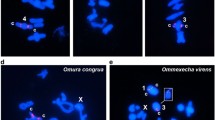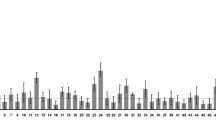Abstract
We have identified two types of structural elements in genomic DNA for annexin I that provide physical evidence of genetic events leading to conserved changes in gene structure. The sequence upstream of the transcribed region in human annexin I contained a rare, Alu-like repetitive element with flanking direct repeats, probably derived from the active BC200 gene via germline retroposition. Nucleotide substitutions in this BC200 insert relative to the 7SL gene and its absence in rodent annexins I identified it as a recent primate pseudogene. Phylogenetic analysis showed that the BC200 gene represents a new clade of primate Alu evolution that branched near the time of appearance of the progenitor to the free left Alu monomer, FLAM-C. Separate analysis identified a Z-DNA motif in pigeon annexin I intron 7 that may represent the vestigial recombination site involved in primordial assembly of the annexin tetrad. These distinct structural features in annexin I genes provide insight into the evolution of Alu repeats and the mechanism of annexin tetrad formation.
Similar content being viewed by others
Abbreviations
- ANXI :
-
human annexin I gene
- Anx1 :
-
rodent or pigeon annexin I gene
- bp:
-
base pair(s)
- FAM:
-
fossil Alu monomer
- FLAM:
-
free left Alu monomer
- FRAM:
-
free right Alu monomer
- Myr:
-
million years
- UTSP :
-
(sequence region) upstream from the transcription start point
References
Altschul SF, Gish W, Miller W, Myers EW, Lipman DJ (1990) Basic local alignment search tool. J Mol Biol 215:403–410
Brini AT, Lee GM, Kinet JP (1993) Involvement of Alu sequences in the cell-specific regulation of transcription of the gamma chain of Fc and T cell receptors. J Biol Chem 268:1355–1361
Britten RJ, Baron WF, Stout DB, Davidson EH (1988) Sources and evolution of human Alu repeated sequences. Proc Natl Acad Sci USA 85:4770–4774
Felsenstein J (1988) Phylogenies from molecular sequences: inference and reliability. Annu Rev Genet 22:521–565
Fernandez MP, Fernandez MR, Morgan RO (1994a) Structure of the gene encoding anchorin CII (chick annexin V). Gene 141:179–186
Fernandez MP, Morgan RO, Fernandez MR, Carcedo MT (1994b) The gene encoding human annexin V has a TATA-less promoter with a high G + C content. Gene 149:253–260
Flower RJ, Rothwell NJ (1994) Lipocortin-1-cellular mechanisms and clinical relevance. Trends Pharmacol Sci 15:71–76
Gao YL, Horseman ND (1994) Structural and functional divergences of the Columbid annexin I-encoding cp37 and cp35 genes. Gene 143:179–186
Hitti YS, Horseman ND (1991) Structure of the gene encoding Columbid annexin Icp35. Gene 103:185–192
Horlick HR, Cheng IC, Wong WT, Wakeland EK, Nick HS (1991) Mouse lipocortin I gene structure and chromosomal assignment: gene duplication and the origins of a gene family. Genomics 10:365–374
Jurka J, Milosavljevic A (1991) Reconstruction and analysis of human Alu genes. J Mol Evol 32:105–121
Jurka J, Walichiewicz J, Milosavljevic A (1992) Prototypic sequences for human repetitive DNA. J Mol Evol 35:286–291
Jurka J, Zuckerkandl E (1991) Free left arms as precursor molecules in the evolution of Alu sequences. J Mol Evol 33:49–56
Kovacic RT, Tizard R, Cate RL, Frey AZ, Wallner BP (1991) Correlation of gene and protein structure of rat and human lipocortin I. Biochemistry 30:9015–9021
Morgan RO, Fernandez MP (1991) Annexins and signal transduction. In: Bailey JM (ed) Advances in prostaglandin, leukotriene, lipoxin and PAF research. Plenum Press, New York, pp 107–122
Quentin Y (1992a) Origin of the Alu family: a family of Alu-like monomers gave birth to the left and the right arms of the Alu elements. Nucleic Acids Res 20:3397–3401
Quentin Y (1992b) Fusion of a free left Alu monomer and a free right Alu monomer at the origin of the Alu family in the primate genomes. Nucleic Acids Res 20:487–493
Quentin Y (1994) Emergence of master sequences in families of retroposons derived from 7SL RNA. Genetica 93:203–215
Raynal P, Pollard HB (1994) Annexins: the problem of assessing the biological role for a gene family of multifunctional calcium- and phospholipid-binding proteins. Biochim Biophys Acta 1197:63–93
Schlaepfer DD, Haigler HT (1990) Expression of annexins as a function of cellular growth state. J Cell Biol 111:229–238
Schroth GP, Chou P-J, Ho PS (1992) Mapping Z-DNA in the human genome. Computer-aided mapping reveals a nonrandom distribution of potential Z-DNA-forming sequences in human genes. J Biol Chem 267:11846–11855
Shen MR, Batzer MA, Deininger PL (1991) Evolution of the master Alu gene(s). J Mol Evol 33:311–320
Sidis Y, Horseman ND (1993) The hinge region of chicken annexin I contains no site for tyrosine phosphorylation. FEBS Lett 329:296–300
Smith PD, Moss SE (1994a) Structural evolution of the annexin supergene family. Trends Genet 10:241–246
Smith PD, Moss SE (1994b) Z-DNA-forming sequences at a putative duplication site in the human annexin VI-encoding gene. Gene 138:239–242
Suarez F, Rothhut B, Comera C, Touqui L, Marie FR, Silve C (1993) Expression of annexin I, annexin II, annexin V, and annexin VI by rat osteoblasts in primary culture—stimulation of annexin I expression by dexamethasone. J Bone Miner Res 8:1201–1210
Thorey IS, Cecena G, Reynolds W, Oshima RG (1993) Alu sequence involvement in transcriptional insulation of the keratin 18 gene in transgenic mice. Mol Cell Biol 13:6742–6751
Tiedge H, Chen W, Brosius J (1993) Primary structure, neural-specific expression, and dendritic location of human BC200 RNA. J Neurosci 13:2382–2390
Ullu E, Tschudi C (1984) Alu sequences are processed 7SL RNA genes. Nature 312:171–172
Watson JB, Sutcliffe JG (1987) Primate brain-specific cytoplasmic transcript of the Alu repeat family. Mol Cell Biol 7:3324–3327
Wahls WP, Wallace LJ, Moore PD (1990) The Z-DNA motif d(TG)30 promotes reception of information during gene conversion events while stimulating homologous recombination in human cells in culture. Mol Cell Biol 10:785–793
Author information
Authors and Affiliations
Corresponding author
Rights and permissions
About this article
Cite this article
Morgan, R.O., Fernández, M.P. A BC200-derived element and Z-DNA as structural markers in annexin I genes: Relevance to Alu evolution and annexin tetrad formation. J Mol Evol 41, 979–985 (1995). https://doi.org/10.1007/BF00173179
Received:
Accepted:
Issue Date:
DOI: https://doi.org/10.1007/BF00173179




